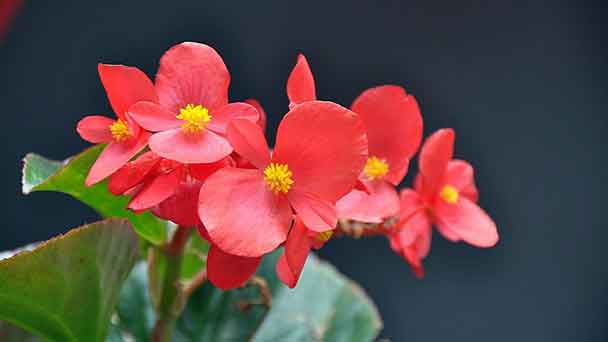Wax Begonias Plant Care & Growing Guide
Written by Iris
Nov 02 2021

Wax begonias are gorgeous plants that you can grow in your garden or at home. The great advantage of these gorgeous plants is that you can easily start growing them directly from seed. Wax Begonias also allows you to start planting in winter or early spring so that new begonias can be planted in the garden when the weather is warm enough. Once you've planted wax begonias in your garden, it's important to take good care of them so they can thrive and produce all those rich, beautiful flowers. While most people think of these exclusively as outdoor plants, in reality, wax begonias also make excellent indoor plants, where they become true perennials.

1. About 12 weeks before the last frost, start your seeds indoors. Sprinkle seeds on well-draining, rich soil.
2. Simply press the seeds gently into the soil with your finger, making sure they are not covered over. They need bright light to germinate.
3. Cover the seeds with a plastic bag or humidity dome and keep the soil moist.
4. Patience is key here. Begonias take a long time to germinate, so don’t give up.
5. Keep your seeds warm with grow lights and keep watch on them. Placing them on a heating mat may help them germinate as well.
6. Once they get their first set of true leaves, you can transplant your baby wax begonias to their own containers and harden them off before planting them up outside.
1. With a clean pair of snips, cut a three to four-inch sprig from your wax begonia in the spring. Be sure the cutting has a few nodes on it.
2. Remove the bottom leaves about two inches from the bottom.
3. Dip the cut end into a rooting hormone.
4. Bury the cut end around two inches into well-draining soil and keep the soil moist. You could additionally place a plastic bag over the plant to keep in the moisture while it is forming roots.
Alternatively, you can skip steps three and four by simply placing your cutting into a jar of water and waiting until roots appear. Once the roots are about an inch or so long, transfer your cutting to dirt, and you’ve got a new little plant.
Stem rot
It is a fungal disease caused by a variety of fungal pathogens like Pythium, Rhizoctonia, Botrytis. The stem rot caused by Botrytis causes the stem to become soft, brown, and gray fuzzy Botrytis spores. Rhizoctonia stem rot causes webbing and sunken brown dry spots on the stem. The plants infected with Pythium show small discolored roots and tubers and blackened stems.
Powdery mildew
It is a fungal disease caused due to excess moisture on the surface of the Wax Begonias leaves. A white powdery layer is formed on the surface of the leaves, preventing the entry of sunlight. The infected leaves wilt and die.
Gray mold
It is a fungal disease where Brown Spots are seen on the surface of leaves and flowers, the stem becomes soft and rotted.
Whiteflies and spider mites can cause the leaves to turn yellow. Slugs and snails can lead to holes in the leaves.
‘Super Olympia’: This is a variety that flowers early and is known for large, white, pink, or red blooms.
'Varsity’: This cultivar is especially good for growing in pots. Its flowers are red, white, or pink.
‘Paint Splash Pink’: This variety offers showy foliage, green with cream spots and marks. It has unique pale pink flowers.
'Victory series': This group has bronze-colored leaves with large, showy flowers.
''Cocktail series': These are dwarf varieties, 6 to 8 inches tall.
| Botanical/Scientific Name | Begonia |
| Common Name | Wax Begonia |
| Plant Type | Herbaceous perennial |
| Light Requirements | Full sun to part shade |
| Soil Requirements | Moist, well-drained soil |
| Bloom Time | Summer into fall; durable, ever-blooming |
| Flower Color | White, pink, red, bicolors |
| Uses | outdoor plants, indoor plants |
| Toxic | Toxic to pets |
Where to Grow Wax BegoniasWhen to Grow Wax BegoniasHow to Grow Wax BegoniasWax Begonias Propagation with SeedsWax Begonias Propagation with Stem CuttingsHow to Care for Wax BegoniasWax Begonias LightingWax Begonias Soil CareWax Begonias WateringWax Begonias Temperature & Humidity CareWax Begonias FertilizerWax Begonias PruningWax Begonias Pests & Diseases CareVarieties of Wax BegoniasWax Begonias Care FAQHow do you keep Wax Begonias blooming?Do Wax Begonias come back year after year?Why do my Wax Begonias keep dying?Is Wax Begonias Toxic?
Where to Grow Wax Begonias
The best place to plant wax begonias is in partial shade or dappled sunlight. Bronze-leafed wax begonias withstand full sun better than the green-leafed varieties. Begonias grow best in slightly acidic soil, so it’s a good idea to amend the soil with compost before planting.When to Grow Wax Begonias
Plant wax begonias in the ground when the threat of frost has passed. Temperatures below 50°F (10°C) will kill the tender annuals.
How to Grow Wax Begonias
Wax Begonias Propagation with Seeds
You can also propagate your wax begonia by seed. If you’d like to try your hand at it, here’s how:1. About 12 weeks before the last frost, start your seeds indoors. Sprinkle seeds on well-draining, rich soil.
2. Simply press the seeds gently into the soil with your finger, making sure they are not covered over. They need bright light to germinate.
3. Cover the seeds with a plastic bag or humidity dome and keep the soil moist.
4. Patience is key here. Begonias take a long time to germinate, so don’t give up.
5. Keep your seeds warm with grow lights and keep watch on them. Placing them on a heating mat may help them germinate as well.
6. Once they get their first set of true leaves, you can transplant your baby wax begonias to their own containers and harden them off before planting them up outside.
Wax Begonias Propagation with Stem Cuttings
Wax begonias are easy to propagate from cuttings. Here's how:1. With a clean pair of snips, cut a three to four-inch sprig from your wax begonia in the spring. Be sure the cutting has a few nodes on it.
2. Remove the bottom leaves about two inches from the bottom.
3. Dip the cut end into a rooting hormone.
4. Bury the cut end around two inches into well-draining soil and keep the soil moist. You could additionally place a plastic bag over the plant to keep in the moisture while it is forming roots.
Alternatively, you can skip steps three and four by simply placing your cutting into a jar of water and waiting until roots appear. Once the roots are about an inch or so long, transfer your cutting to dirt, and you’ve got a new little plant.

How to Care for Wax Begonias
Wax Begonias Lighting
While Wax Begonias can’t tolerate hours of direct sunlight, these plants bloom in a combination of partial shade and soft light. The best location for this compromise is on the north or east side of your home, beneath a large tree or covered patio to filter the sunlight. In more densely shaded spots, flowering tuberous and fibrous begonias tend to develop more leaves than blooms, though rhizomatous begonias (which are grown for their foliage) will flourish.Wax Begonias Soil Care
The best soil for Wax Begonias is moderate to slightly acidic of pH 5.6 to 6.5, and of a loose, rich, loamy type. Compost may be mixed with the soil; it should preferably contain coir but be free of peat.Wax Begonias Watering
Water the wax begonias one or two times weekly, supplying 1 inch of water each time. Less water may be needed if it rains. Water the plants often enough to maintain moist soil to a 6-inch depth, but avoid overwetting the soil and creating soggy conditions.Wax Begonias Temperature & Humidity Care
Wax begonias thrive in average room temperatures. The ideal temperature range for begonia semperflorens is between 60°F and 75°F (16°C – 24°C). Growing in these temperatures encourages non-stop blooming. Try to ensure that wax begonias grow in relative room humidity of around 50 percent. If indoor conditions are especially dry, sit the plant pot on a pebble tray and water. Just make sure that the pot doesn’t sit in water, but on the small stones. Indoor wax begonias must have good ventilation. If air circulation is inadequate, you may notice signs of fungal issues on foliage—a white powdery substance on leaves caused by mildew.Wax Begonias Fertilizer
Fertilize the wax begonias with a balanced, soluble fertilizer, such as an 8-8-8 or a 10-10-10 blend, when the plants actively grow from spring to fall. Mix the fertilizer blend with water at the fertilizer package's recommended strength or ratio, and apply the solution monthly; an option is to dilute the fertilizer and water to one-quarter of the fertilizer package's recommended strength or ratio and apply the solution weekly. Use the solution to water the wax begonias near their bases so the solution soaks into the soil immediately.Wax Begonias Pruning
Wax Begonias benefit from a pinch-and-deadhead routine. Pinch off buds if flowers and buds are abundant to prevent the plant from going under the weight of its blooms, and lop off spent blooms to maintain vitality. In spring, mature plants may be thinned and sculpted by pruning if there is an excess of stems. Spring pruning is also done to fashion bushy plants. Pinch off or prune selected stem tips to the first or second bud when they are 7.5 to 15 centimeters. Do so twice or thrice every four weeks.Wax Begonias Pests & Diseases Care
These plants are not prone to many diseases or pests. Overwatering and overhead watering can result in fungal diseases like leaf spots and root rot. Avoid excess moisture in the soil and on the surface of the Wax Begonias plants. Water the plants at the base.Stem rot
It is a fungal disease caused by a variety of fungal pathogens like Pythium, Rhizoctonia, Botrytis. The stem rot caused by Botrytis causes the stem to become soft, brown, and gray fuzzy Botrytis spores. Rhizoctonia stem rot causes webbing and sunken brown dry spots on the stem. The plants infected with Pythium show small discolored roots and tubers and blackened stems.
Powdery mildew
It is a fungal disease caused due to excess moisture on the surface of the Wax Begonias leaves. A white powdery layer is formed on the surface of the leaves, preventing the entry of sunlight. The infected leaves wilt and die.
Gray mold
It is a fungal disease where Brown Spots are seen on the surface of leaves and flowers, the stem becomes soft and rotted.
Whiteflies and spider mites can cause the leaves to turn yellow. Slugs and snails can lead to holes in the leaves.

Varieties of Wax Begonias
Some popular cultivars include:‘Super Olympia’: This is a variety that flowers early and is known for large, white, pink, or red blooms.
'Varsity’: This cultivar is especially good for growing in pots. Its flowers are red, white, or pink.
‘Paint Splash Pink’: This variety offers showy foliage, green with cream spots and marks. It has unique pale pink flowers.
'Victory series': This group has bronze-colored leaves with large, showy flowers.
''Cocktail series': These are dwarf varieties, 6 to 8 inches tall.

Wax Begonias Care FAQ
How do you keep Wax Begonias blooming?
Many Wax Begonias varieties are bred for continuous bloom with little to no effort. Fertilizing can help keep the blooms coming. Use a balanced fertilizer every 2 weeks, and make sure the begonia gets the right amount of sun, shade, and water.Do Wax Begonias come back year after year?
Most Wax Begonias are annuals (last only one season). You can save tubers from tuberous begonias to replant the next year or bring annual begonias in as houseplants in winter. Some rhizomatous and hardy begonias (Begonias grandis) are perennial, or come back year after year, in warmer regions.Why do my Wax Begonias keep dying?
Wax Begonias typically dieback, or at least go dormant, in the fall. A freeze will kill most. But if begonias growing as bedding or container plants in summer die, the cause is the most likely stem or rhizome rot. Even though these are tropical plants, they prefer soil that is moist, not soggy. Overwet soil can damage the plant.Is Wax Begonias Toxic?
Plants in the family Begoniaceae, such as wax begonias, are poisonous to cats and dogs. The ASPCA says that begonias contain soluble calcium oxalates. Ingesting the begonia leaves, stems, or roots can result in vomiting or excessive drooling.Latest Updated
- Benefits of Bugleweed - 7 Science-backed Health Benefits
- Bugleweed Dangers & Side Effects - Is It Poisonous?
- How to Plant Evergreen Trees - What You Should Know
- When to Plant Evergreens - Grow Guide for Evergreen Trees
- 12 Wonderful Evergreen Shrubs for Your Garden
- 12 Popular Evergreen Plants with Pictures for Beginners
- When And How To Prune A Lilac Bush Like a Pro
- How to Grow & Care for Lilac Vine (Hardenbergia Violacea)
- Japanese Lilac Tree (Syringa Reticulata) Care & Propagation Guide
- Shumard Oak Pros and Cons - What to Know
Popular Articles
- Winter maintenance of Antirrhinum Majus
- How to Grow Terminalia Mantaly Tree
- How to Grow and Care for Crossostephium Chinense
- How to grow Antirrhinum Majus in spring
- Peristeria Elata (Dove Orchid) Profile: Info & Care Guide
- Underwatered Snake Plant (Sansevieria Trifasciata) - Signs And How To Fix
- How to Care for Brazilian Jasmine Plant (Mandevilla Sanderi)
- How to Grow & Care for Graptopetalum Purple Delight in Summer
- Rosa Chinensis (China Rose): Plant Growing & Care Tips
- How to Care for Baby Sun Rose (Aptenia Cordifolia)